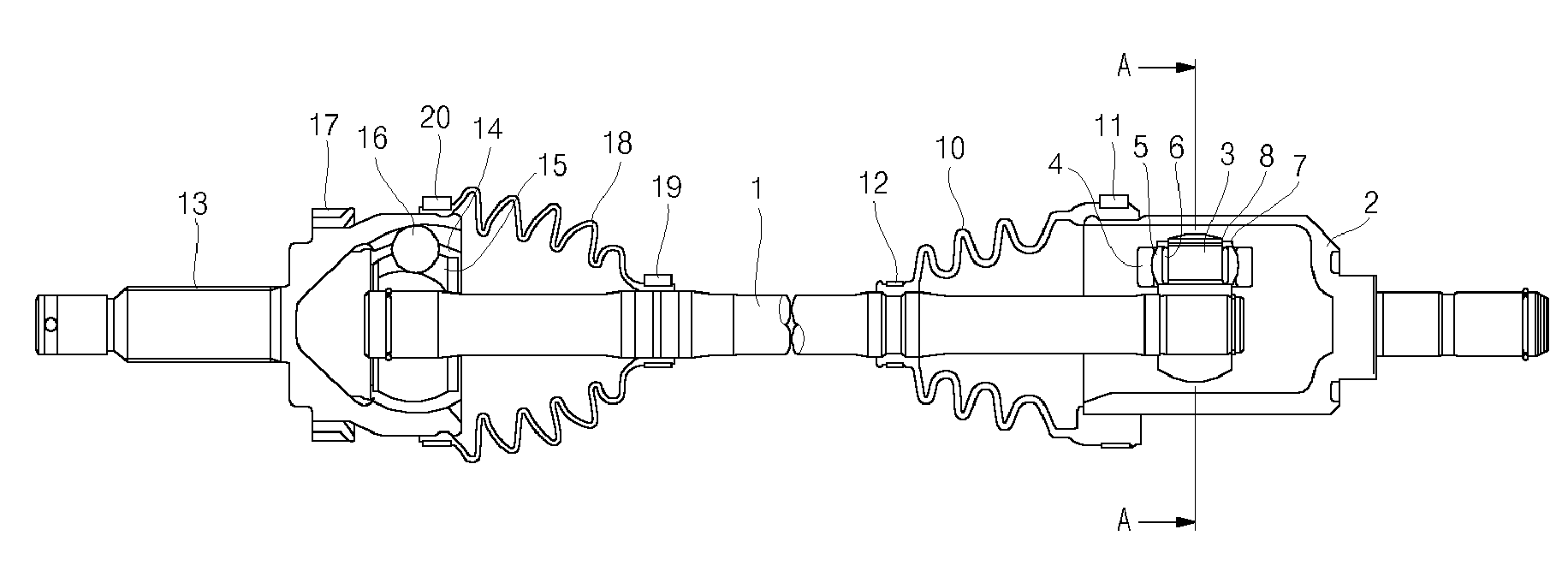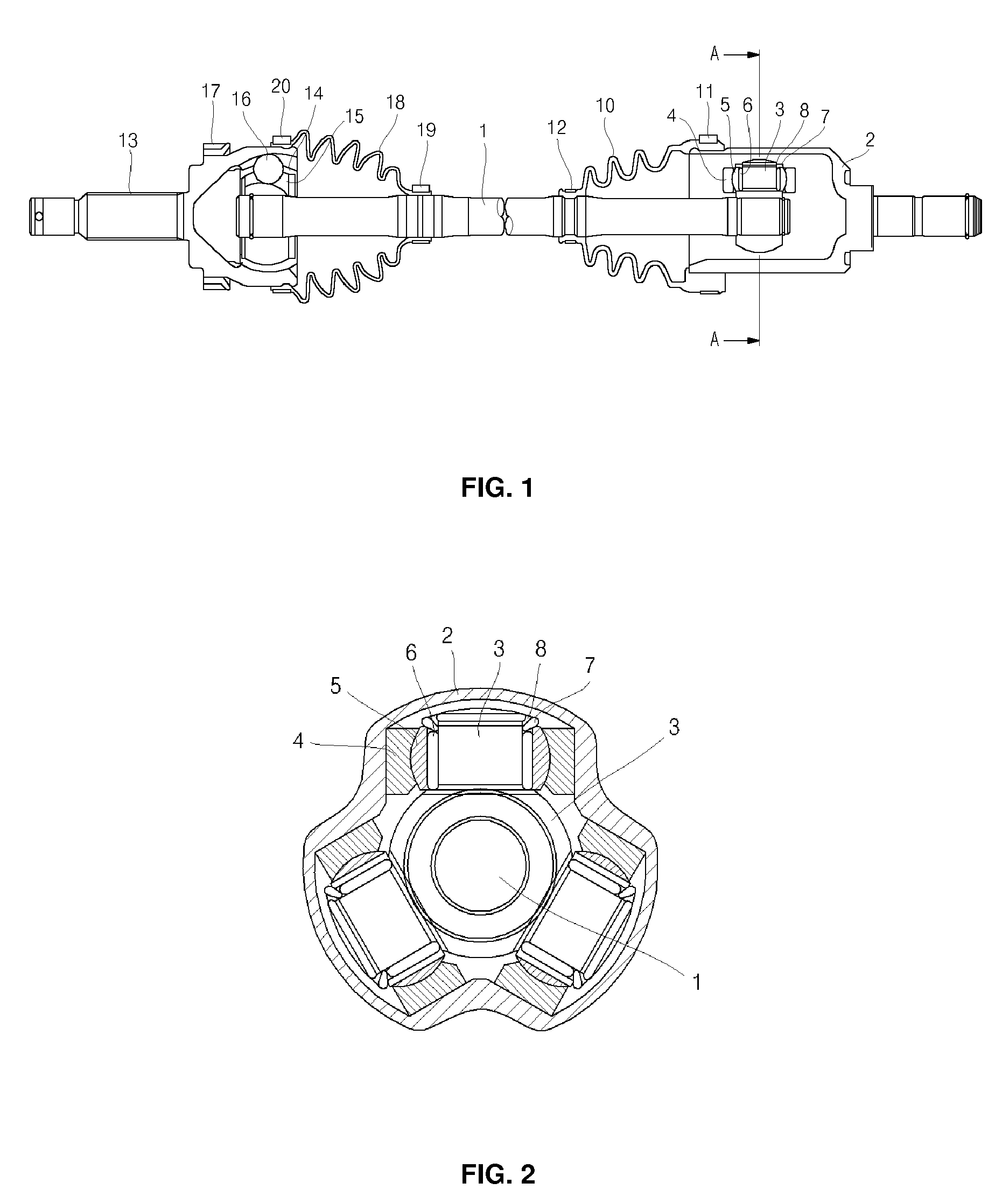Tripod Type Constant Velocity Joint
a constant velocity joint, tripod technology, applied in the direction of yielding couplings, rotary machine parts, couplings, etc., can solve the problems of increasing surface pressure, deteriorating durability of constant velocity joints, and inability to ensure power transmission stability, so as to prevent driving force from being concentrated and generate excessively large frictional forces
- Summary
- Abstract
- Description
- Claims
- Application Information
AI Technical Summary
Benefits of technology
Problems solved by technology
Method used
Image
Examples
first embodiment
[0071] Referring to FIGS. 10 and 11, the tripod type constant velocity joint in accordance with the present invention comprises a housing 20 having three track grooves 20b which are defined at trisected positions of the housing 20 along the circumferential direction and extend in the radial direction, a spider 21 having three polyhedral trunnions 22 which are projectedly formed at trisected positions of the spider 21 along the circumferential direction to be respectively inserted into the track grooves 20b of the housing 20 and each of which has at least two polygonal surfaces, inner rollers 23 the circumferential inner surface of each of which has a curved contour for surrounding the polyhedral trunnion 22, a plurality of needle rollers 24 assembled to the circumferential outer surface of each inner roller 23, and outer rollers 25 each formed to be rotated through the needle rollers 24, to be moved in the axial direction of the inner roller 23, and to be moved in the axial directio...
second embodiment
[0082] Referring to FIGS. 25 and 26, the tripod type constant velocity joint in accordance with the present invention comprises a housing 20′ having three track grooves 20b′ which are defined at trisected positions of the housing 20′ along the circumferential direction and extend in the radial direction, a spider 21′ having three polyhedral trunnions 22′ which are projectedly formed at trisected positions of the spider 21′ along the circumferential direction to be respectively inserted into the track grooves 20b′ of the housing 20′ and each of which has at least two independent contact points or contact surfaces on each side and at least four independent contact points or contact surfaces on both sides, inner rollers 23′ the circumferential inner surface of each of which has a curved contour for surrounding the polyhedral trunnion 22′, a plurality of needle rollers 24′ assembled to the circumferential outer surface of each inner roller 23′, and outer rollers 25′ each formed to be ro...
third embodiment
[0092] Referring to FIGS. 35 and 36, the tripod type constant velocity joint in accordance with the present invention comprises a housing 20″ having three track grooves 20b″ which are defined at trisected positions of the housing 20″ along the circumferential direction and extend in the radial direction, a spider 21″ having three polyhedral trunnions 22″ which are projectedly formed at trisected positions of the spider 21″ along the circumferential direction to be respectively inserted into the track grooves 20b″ of the housing 20″ and each of which has at least four surfaces such that at least one independent contact surface is positioned on each side, inner rollers 23″ the circumferential inner surface of each of which has a curved contour for surrounding the polyhedral trunnion 22″, a plurality of needle rollers 24″ assembled to the circumferential outer surface of each inner roller 23″, outer rollers 25″ each formed to be rotated through the needle rollers 24″, to be moved in th...
PUM
 Login to View More
Login to View More Abstract
Description
Claims
Application Information
 Login to View More
Login to View More - R&D
- Intellectual Property
- Life Sciences
- Materials
- Tech Scout
- Unparalleled Data Quality
- Higher Quality Content
- 60% Fewer Hallucinations
Browse by: Latest US Patents, China's latest patents, Technical Efficacy Thesaurus, Application Domain, Technology Topic, Popular Technical Reports.
© 2025 PatSnap. All rights reserved.Legal|Privacy policy|Modern Slavery Act Transparency Statement|Sitemap|About US| Contact US: help@patsnap.com



